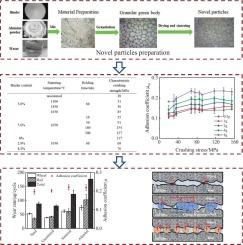Study on wheel-rail adhesion restoration effect by sanding using novel adhesion-enhancement particles
IF 4.6
2区 工程技术
Q2 ENGINEERING, CHEMICAL
引用次数: 0
Abstract
Hard particles are widely used for wheel-rail adhesion enhancement under low adhesion conditions, but it would intensify the wheel-rail damage. In order to achieve the same or better adhesion restoration effect as commonly used particles (e.g., Silica sand, Alumina, etc.) while reducing the wheel-rail damage caused by particles, a novel adhesion-enhancement particle was prepared in this study. The crushing stress of the novel particle with different preparation parameters were studied on a uniaxial compression apparatus. The wheel-rail adhesion restoration effect caused by the novel particles were studied under oil condition by a twin-disc wheel-rail testing machine. Results indicated that when the particle crushing stress increased from 20 MPa to 68 MPa, the adhesion coefficient increased. Then the adhesion coefficient kept stable after particle crushing stress exceeded 68 MPa. The novel adhesion-enhancement particle showed a better performance on wheel-rail adhesion improvement compared to sand and alumina. Considering the adhesion coefficient, wear and damage of wheel-rail, the novel unsintered particles with crushing stress of 20 MPa could be used as a substitute for sand on adhesion coefficient improvement under conditions with low requirements for adhesion enhancement, and the sintered novel adhesion-enhancement particles with crushing stress of 68 MPa could be optimal particles for wheel-rail adhesion restoration under high requirements for adhesion enhancement condition.

新型粘接增强颗粒砂磨修复轮轨粘接效果的研究
在低附着力条件下,硬质颗粒广泛用于增强轮轨附着力,但会加剧轮轨损伤。为了达到与常用颗粒(如硅砂、氧化铝等)相同或更好的粘接恢复效果,同时减少颗粒对轮轨的损伤,本研究制备了一种新型的粘接增强颗粒。在单轴压缩装置上研究了不同制备参数下新型颗粒的破碎应力。在双盘式轮轨试验机上,研究了新型颗粒在有油条件下对轮轨附着恢复效果的影响。结果表明,当颗粒破碎应力从20 MPa增加到68 MPa时,附着系数增大;颗粒破碎应力超过68 MPa后,附着系数保持稳定。与砂和氧化铝相比,新型粘接增强颗粒在改善轮轨粘接方面表现出更好的性能。综合考虑粘着系数、磨损和轮轨损伤等因素,在对粘着增强要求较低的条件下,未烧结新型颗粒破碎应力为20 MPa可替代砂土提高粘着系数,在对粘着增强要求较高的条件下,烧结新型颗粒破碎应力为68 MPa可作为恢复轮轨粘着的最佳颗粒。
本文章由计算机程序翻译,如有差异,请以英文原文为准。
求助全文
约1分钟内获得全文
求助全文
来源期刊

Powder Technology
工程技术-工程:化工
CiteScore
9.90
自引率
15.40%
发文量
1047
审稿时长
46 days
期刊介绍:
Powder Technology is an International Journal on the Science and Technology of Wet and Dry Particulate Systems. Powder Technology publishes papers on all aspects of the formation of particles and their characterisation and on the study of systems containing particulate solids. No limitation is imposed on the size of the particles, which may range from nanometre scale, as in pigments or aerosols, to that of mined or quarried materials. The following list of topics is not intended to be comprehensive, but rather to indicate typical subjects which fall within the scope of the journal's interests:
Formation and synthesis of particles by precipitation and other methods.
Modification of particles by agglomeration, coating, comminution and attrition.
Characterisation of the size, shape, surface area, pore structure and strength of particles and agglomerates (including the origins and effects of inter particle forces).
Packing, failure, flow and permeability of assemblies of particles.
Particle-particle interactions and suspension rheology.
Handling and processing operations such as slurry flow, fluidization, pneumatic conveying.
Interactions between particles and their environment, including delivery of particulate products to the body.
Applications of particle technology in production of pharmaceuticals, chemicals, foods, pigments, structural, and functional materials and in environmental and energy related matters.
For materials-oriented contributions we are looking for articles revealing the effect of particle/powder characteristics (size, morphology and composition, in that order) on material performance or functionality and, ideally, comparison to any industrial standard.
 求助内容:
求助内容: 应助结果提醒方式:
应助结果提醒方式:


